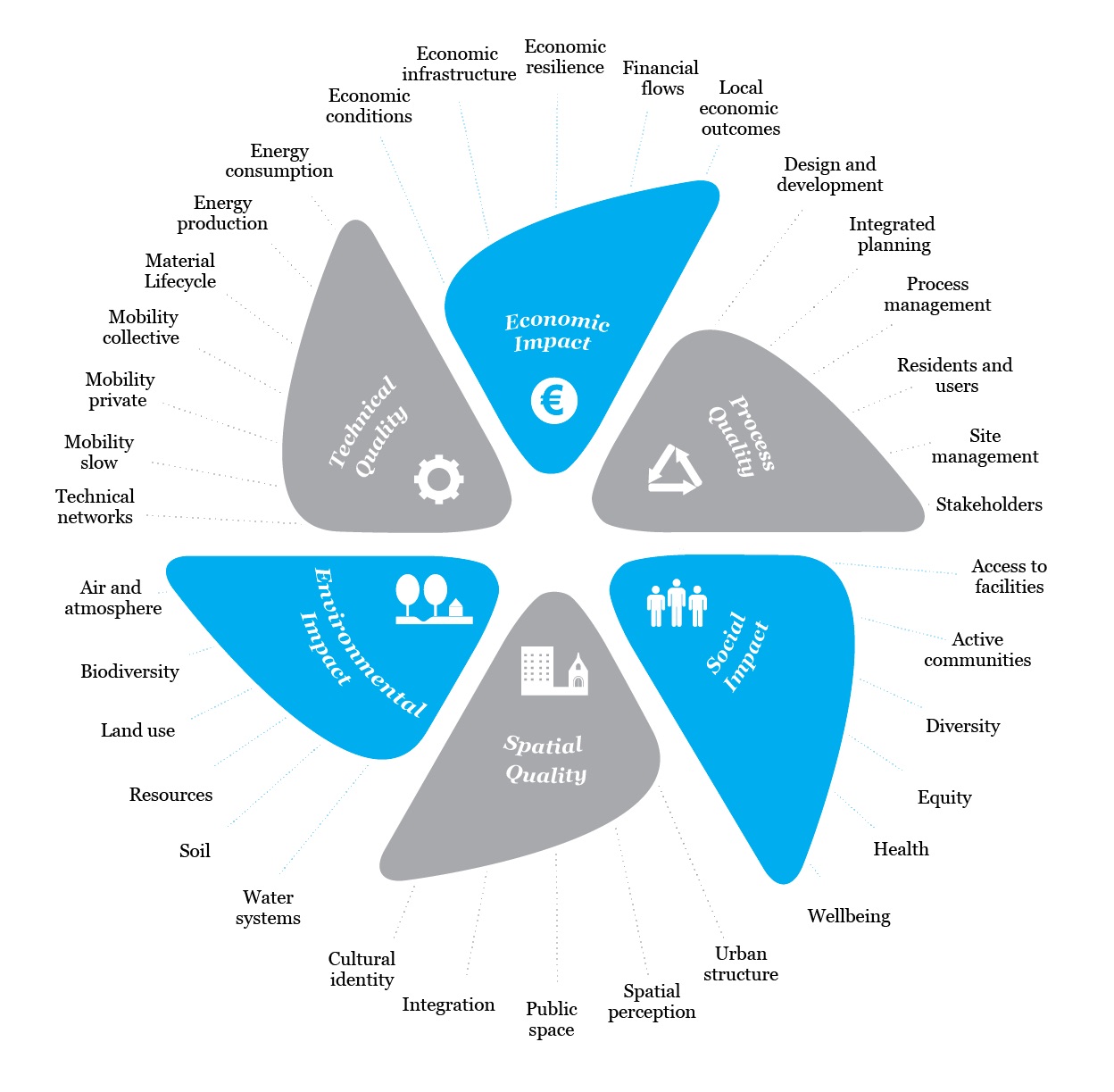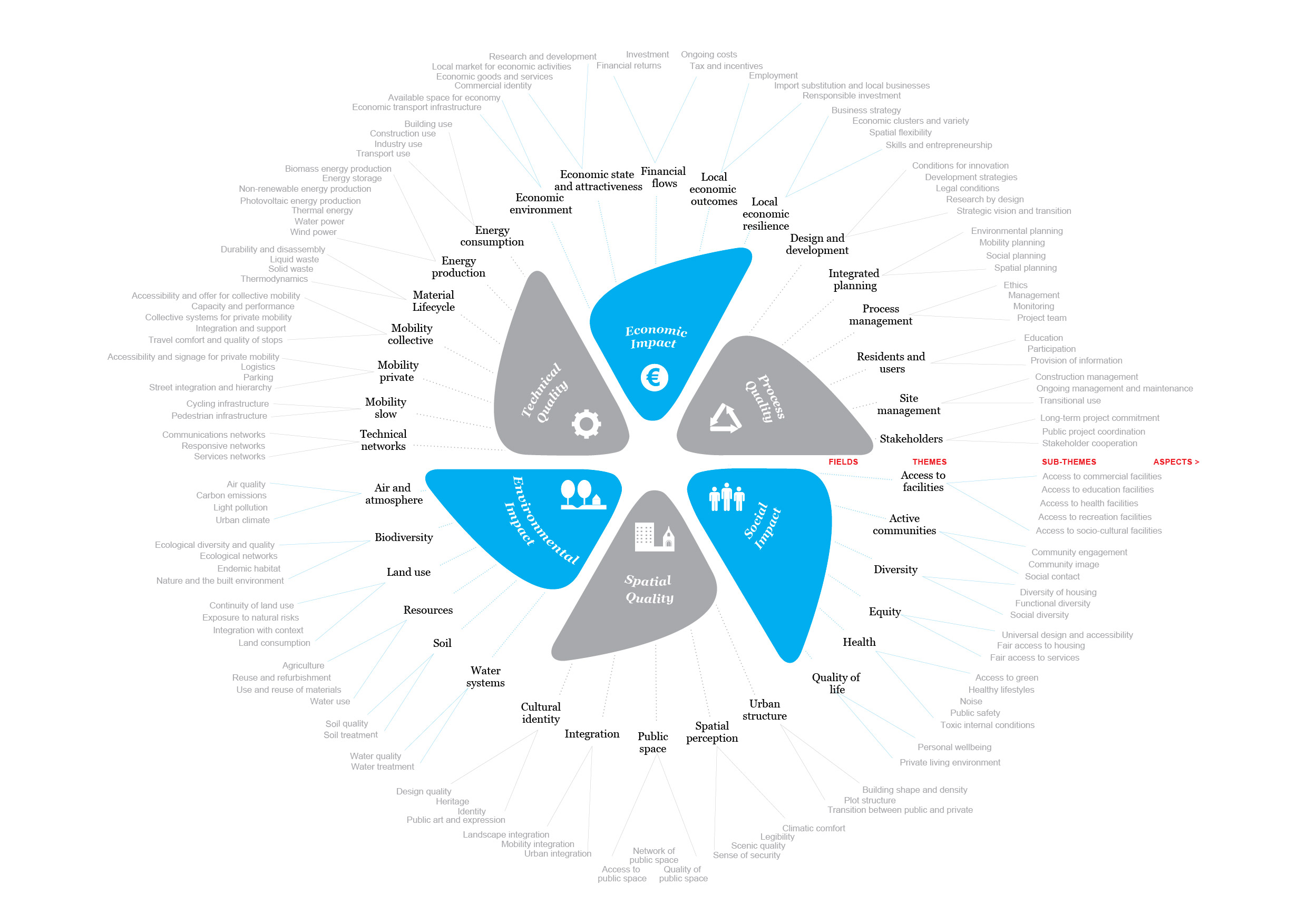
Theory
- Existing approaches: Sustainability is a complex term that has become controversial due to its lose definition. We first explored a number of established theories to help frame one for urban areas.
- Theory: We formed a theoretical framework based on ’Six Fields of Sustainable Urbanism’. This forms the foundation of our Compass approach.
- Hierarchy of knowledge: To work with sustainability it is necessary to easily identify critical details while having a perspective of the bigger picture. This means being able to jump between dimensions of knowledge.
- Leverage points: If we accept that sustainability is a process and not an end in itself, one must approach urban scale sustainability by looking for the most relevant places to intervene. If intervening in a system, feedback must be carefully analysed to avoid unintended consequences.
1. Context
Accepting that sustainability is highly complex, we needed a clear and simple foundation that we could hang more tangible issues off such as bike lanes, renewable energy or wetlands. After early research into established approaches to sustainability, we found few fitted urbanism.
There are many existing approaches to sustainability – each varying based on context, vocation or world view. There are five approaches that help illustrate the urban scale approach we describe below – these include: Triple Bottom Line, Natural Step, the Five Capitals, the Systems Model and DNGB. Each of these share similar foundations used by most sustainability assessment methodologies that we have researched.
Fundamentally we required an approach to sustainability that could be applied to almost any urban problem irrespective of scale or location. As a result we synthesised the concepts described above down to six key themes evolving from those above.

Influences
Below we explain the basic concept of five approaches to sustainability. We also explain how each is applicable to urban and what we have taken from each.
Triple Bottom Line
As urbanism challenges are complex, we started with the basic Brundtland definition of sustainability – addressing today’s needs without impacting the opportunities for future generations. The three main themes – economy, environment and society – are a logical division of sustainability however as they are so general, they have allowed much confusion and false or incomplete interpretation of the approach. ‘Greenwashing’ and other forms of ‘weak sustainability’ haven’t brought the debate much credibility where economic issues take precedence over society or the environment.
But the basic thought that a sustainable development should be good for nature, for man and for the welfare system, is a fundamental one that shouldn’t be contested.
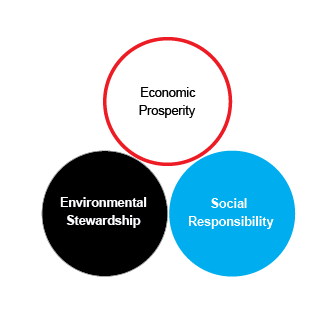
The Natural Step
Natural Step was created soon after the Brundtland report and took a very environment/resources approach to sustainability. The idea posited that if we could simplify sustainability down to a few core principles based on the earth’s ‘carrying capacity’, then we would have basic tools to deal with sustainability. There are four basic principles based on the availability and use of resources. Large companies such as IKEA were inspired by such an approach and took great steps forward in supporting organisations such as the Forest Stewardship Council.
There are two reason why we have included this approach. Firstly at its core, sustainability is about environmental systems and the flow of resources. However, urban areas are not based solely on the flows of physical resources but are also depending heavily on human and financial resources. The Natural Step proves why we must take a broader perspective within an environmental context.
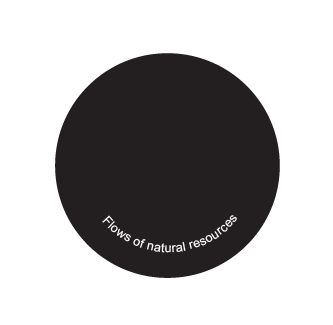
The Five Capitals
A ‘strong sustainability’ approach should emphasize that economic activities are merely a result of certain socio-cultural conditions that are in turn dependent on the capacity of the environment. Such an approach was elaborated by the Forum of the Future in a concept called the five capitals: ‘financial capital’ and ‘manufactured capital’ that are rooted in ‘social capital’ and ‘human capital’, which find their foundation in the natural capital. This nuanced distinction makes the concept of sustainability clearer and explains the dependencies between the main topics.
A sustainable development therefore is one that takes all five capitals into account and makes sure that no capital is lost in the dependencies between them.
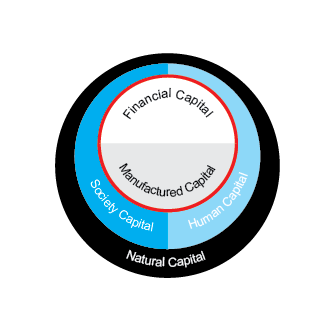
The Systems Model
In addition to the five capitals, the English Engineering firm, Halcrow, elaborated their own approach to sustainability. Their ‘HalSTAR’ toolkit and rating system is based on a ‘systems model’ that adds the significant dimensions of time and scale. This turns sustainability from a static concept into one that involves evolution and adaptation.
The importance of time and scale is that it describes the dynamic nature of urbanism. Change is constant in urban areas and the impact can be interpreted very differently if viewed across different time-scales and different physical areas of influence.
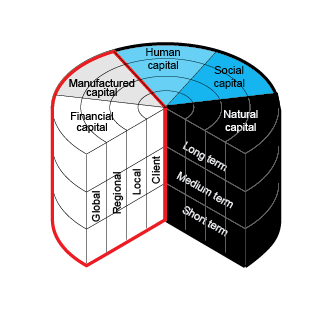
DGNB
An important aspect when evaluating processes and systems on their sustainability is the role of technology. New technologies allow improving the environmental impact of projects and systems, without having to abandon modern comfort and consumption patterns. However, it is crucial that these technological solutions aren’t purely environmentally oriented, but also take the social and economic dimension of sustainability into account.
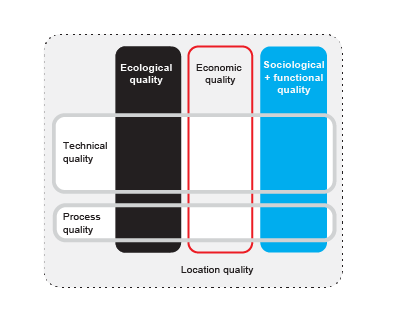
An important aspect when evaluating processes and systems on their sustainability is the role of technology. New technologies allow improving the environmental impact of projects and systems, without having to abandon modern comfort and consumption patterns.Therefore it is crucial that these technological solutions aren’t purely environmentally oriented, but also take the social and economic dimension of sustainability into account.
The German DGNB has developed a sustainability approach for architectural and urban design projects in which also technology plays a role. Their model starts from five qualities: ecological, economic, socio-cultural and functional, technical and process quality. This approach is based on the triple bottom line, but the process quality adds to HalSTAR’s time-related concept and the model includes technology as a final element. The five qualities are supported by a sixth one, that of the location. Still, the concept of location quality as interpreted by the DGNB, misses an essential dimensions that characterizes all urban projects and systems: that of space as a defining element for their cultural, aesthetic and historical value.
2. Six Fields of Sustainable Urbanism
Based on these various approaches, the ‘sustainability compass’ combines six Fields: Environment, Society and Economy are the Brundtland-related dimensions of the impact that systems have on each other, whereas Technology, Space and Process are the three dimensions of quality that help distinguish sustainability for complex urban challenges.
We distribute the six fields in a circle as we do not find that one field should claim priority over the others. As noted above, ‘Strong sustainability’ should be based on environmental issues however in practice we know that it remains a weak motivating factor in urban areas. Environmental issues, for example, need to be packaged into general project objectives.
Each topic has strongest connections with the topic beside it. For example Space is most related to Society and Environment while Technology is most related to the Environment and the Economy.
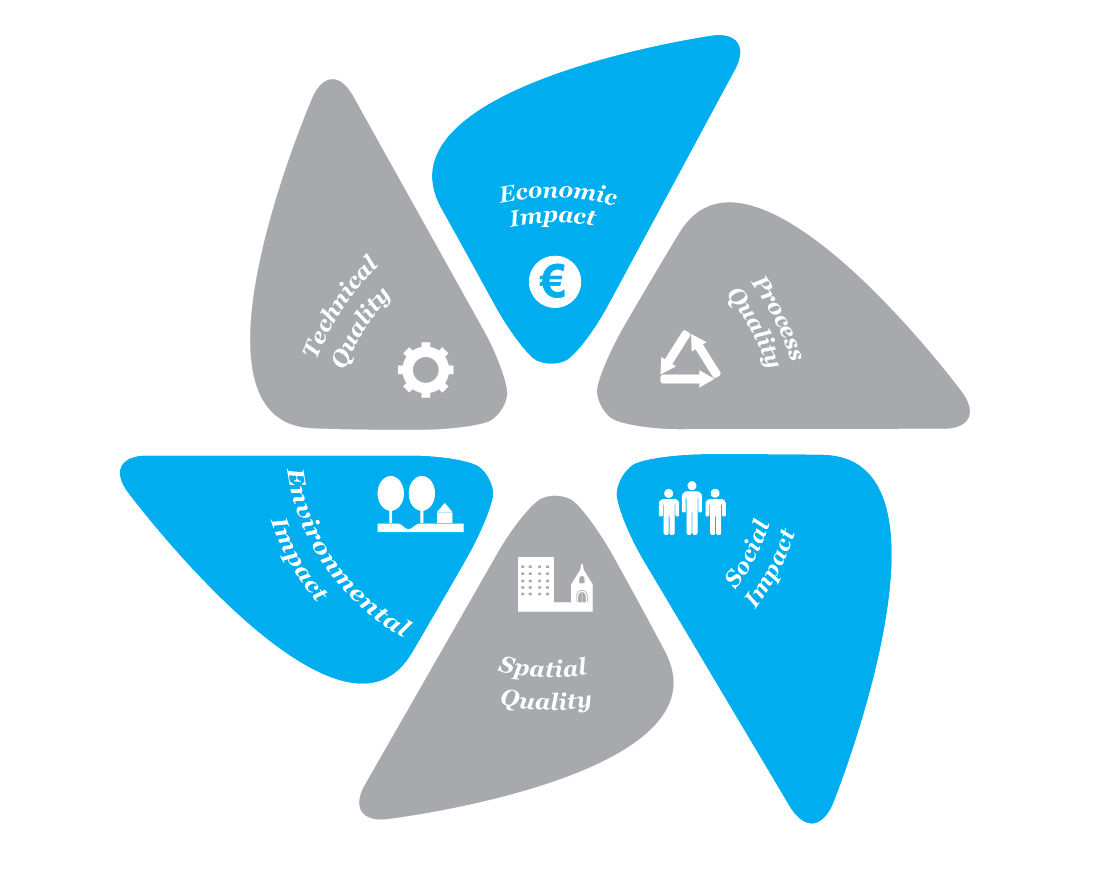
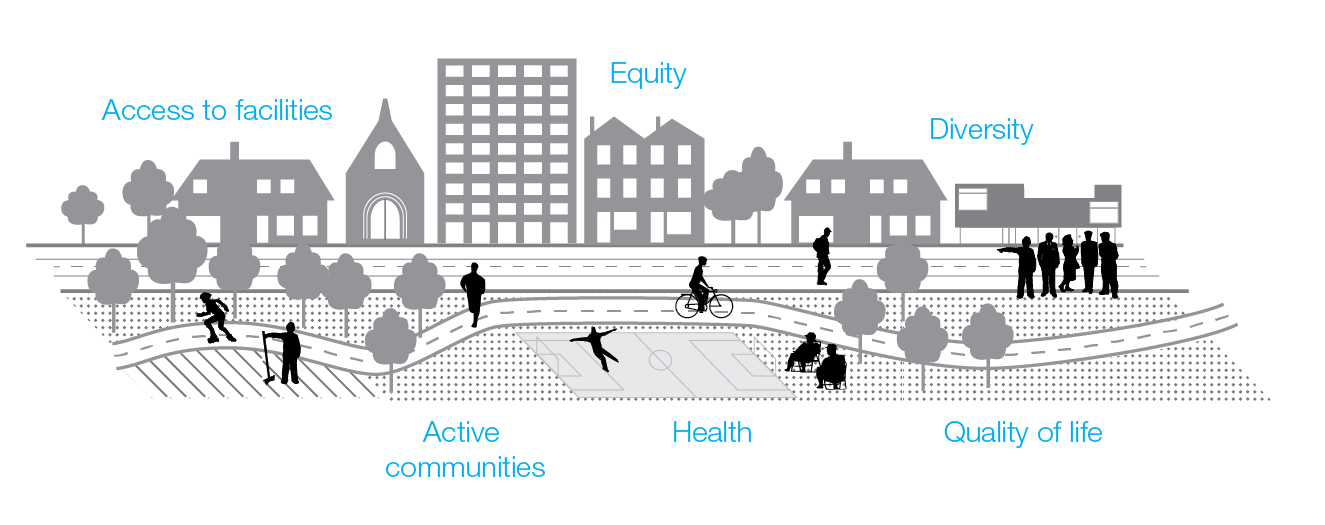
Social impact is about the way physical space affects the way people interact. In terms of urban planning this involves identifying links between space, functions and the way people act. It then involves finding functions which may have a positive effect or further improve quality of life.
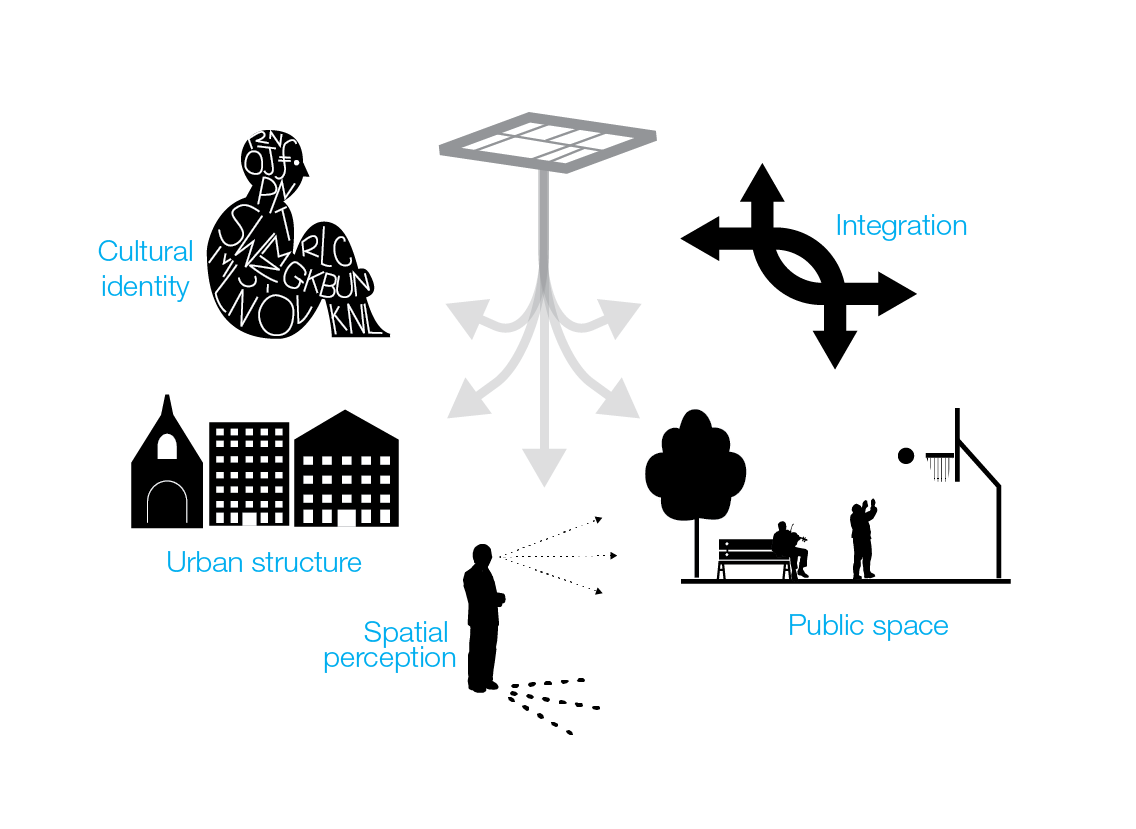
Spatial quality looks at the value relationship between the physical environment and the experiential quality of using it. Experience and perception are central – spatial logic, readability and cultural identity. The space is not seen as an abstract context, but as a subjective framework that makes activities possible and which is inextricably linked to its cultural and social environment.
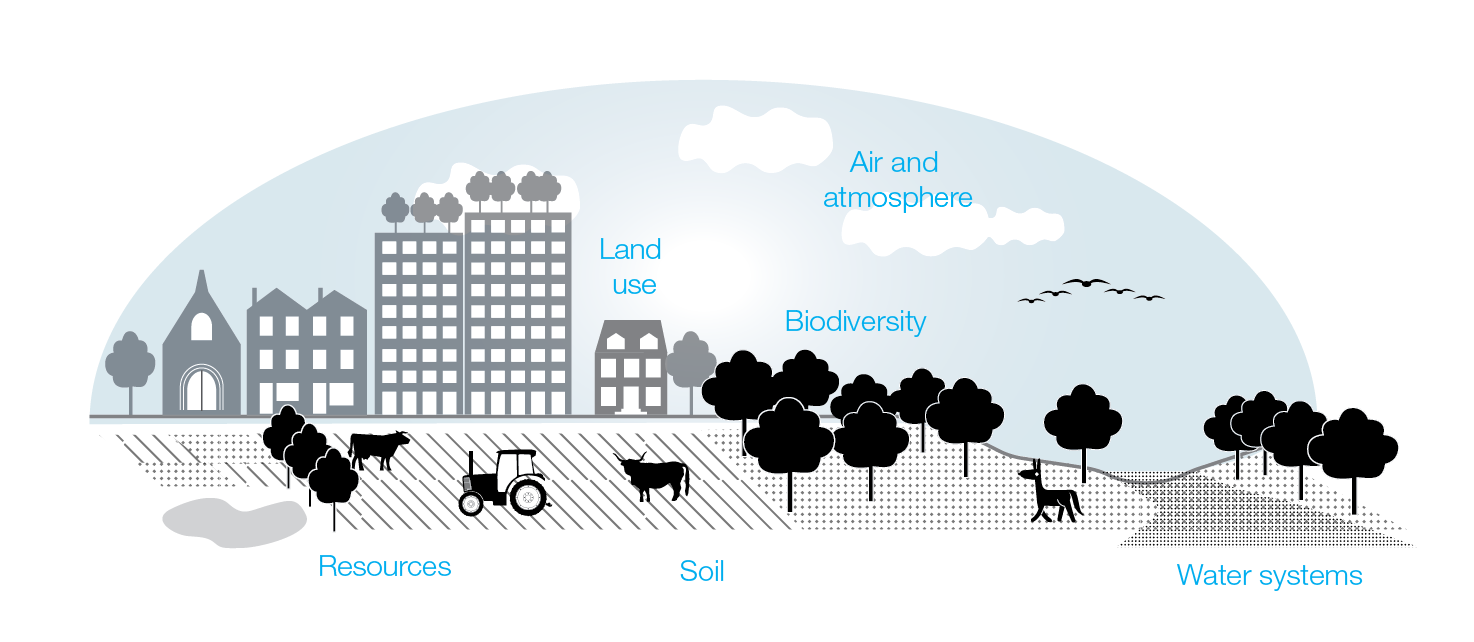
Environmental impact regards the extent to which the use of the physical environment influences the functioning of ecological systems in the area. There are the various elements covered by our natural environment includ: air, water, soil, resources, land use and biodiversity.
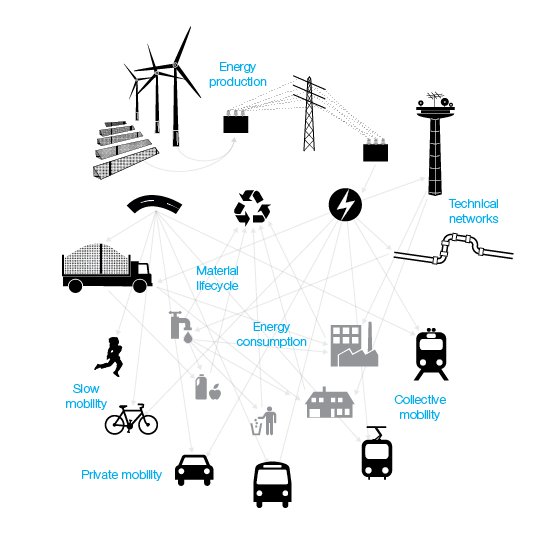
Technical quality looks at the technological objects, structures and processes that are used to generate ecological, social and economic benefits. In addition, their performance is analysed within each of these three dimensions to avoid that technological solutions would have an unforeseen negative impact. In an urban environment, especially energy, transport and utilities play an important role in the technical quality.
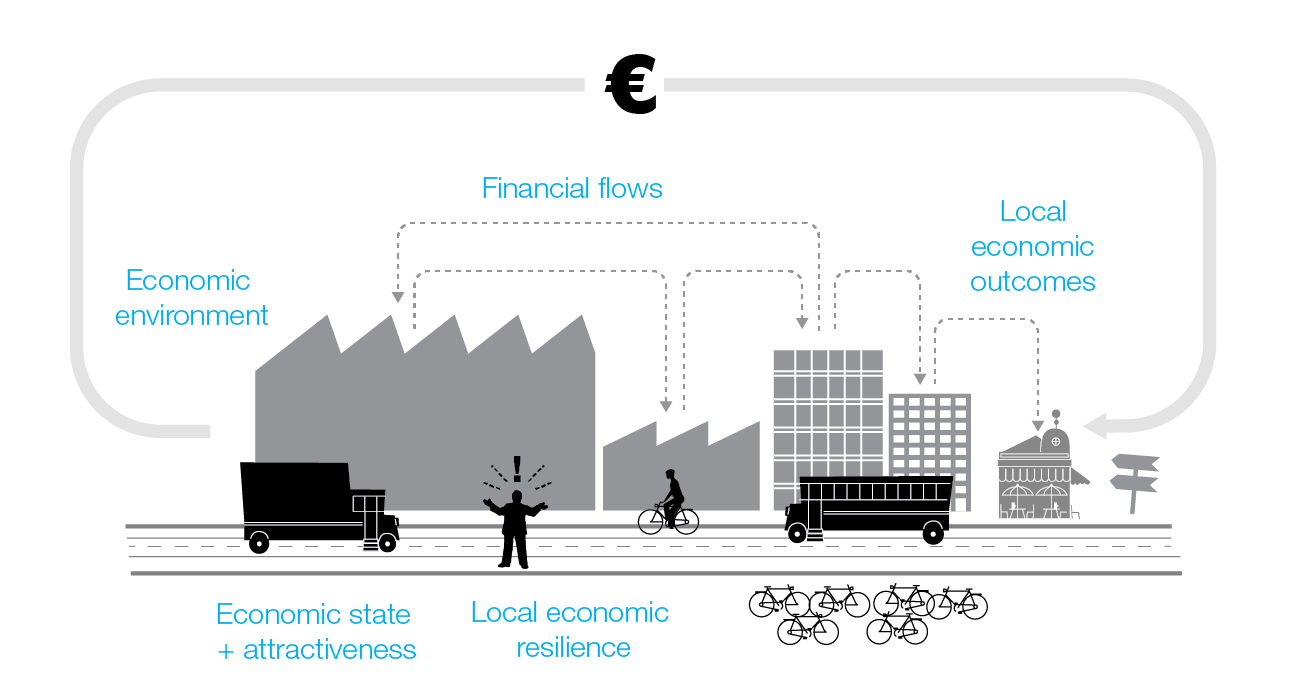
Economic impact is about the connection between places and their generative economic capacity. Therefore it consists of identifying the conditions between functions, skills and the performance of space to allow sustainable prosperity to occur. Spatial planning must also take into account direct and indirect investment and returns.
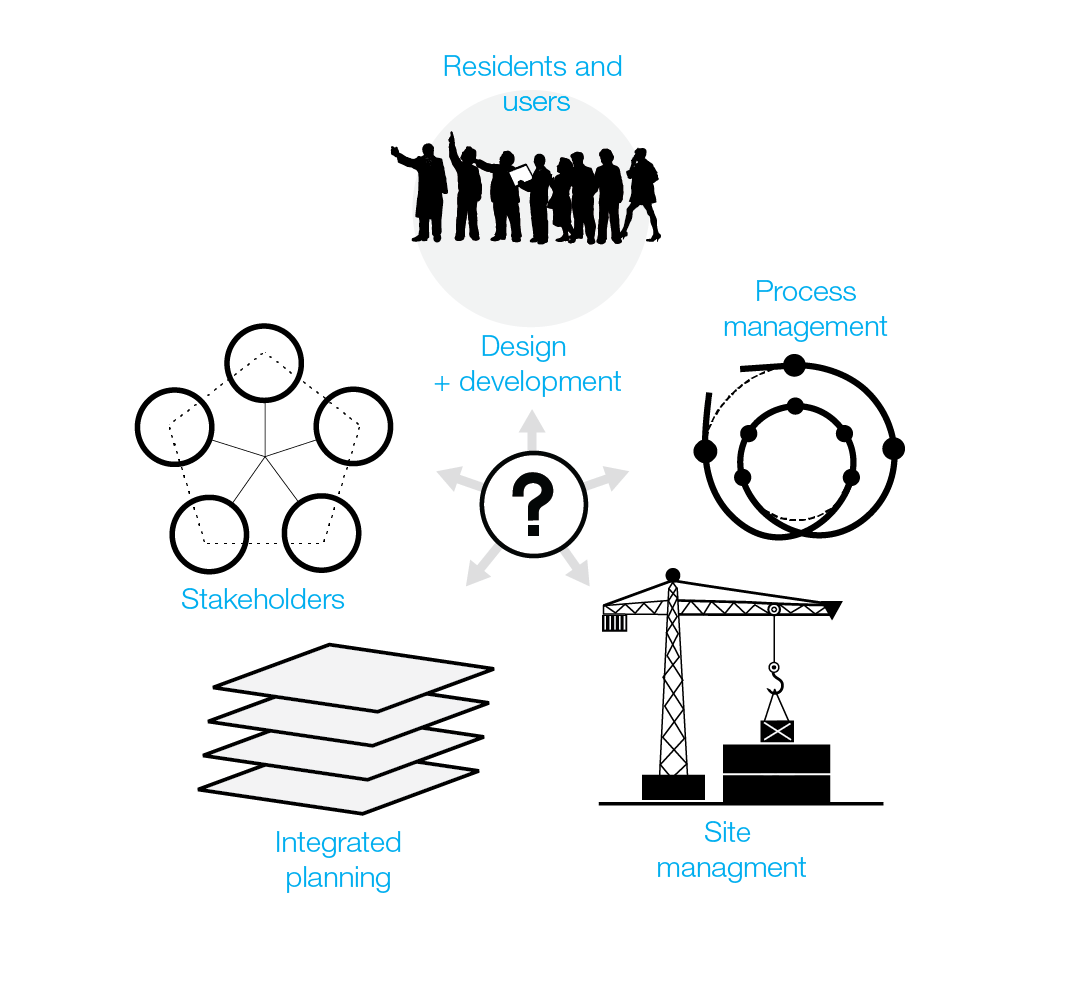
Process Quality relates to the relationships between investment in the personnel and activities for the organisation and realisation of sustainable urban planning. Without a suitable strategy for the consultation, implementation and support from a project – it is very possible the ‘sustainable’ project will not be realisable.
Impact and Quality
A final detail that has been added to the research of the sustainability models (above), is that we make a difference between the well-functioning of a system itself, and the way it influences its surroundings and other systems. This we consider is about the difference between impact and quality.
Impact is about the influence over a larger system. It is about sustainable relationships between systems (usually focusing beyond a site or urban area) – it is about networks, the larger environmental system, the economy,… We consider impact on the level of economy, society and environment and assess it both internally and externally. A real estate development for example has a social impact for the people that will be living in it, but also for the people living in the surroundings, future users of the public spaces,… Looking at impact in this way also introduces the notion of scale: not only the scale of the project, but also of the impact area. A single project or site rarely has a radical influence over a larger region, but can be a ground shaking change for the surrounding neighbourhood. Strategic visions for the development of a whole city or urban region on the other hand can have national or global impact.
Quality is largely focused on the scope of a project or site. It focuses on the long term level of excellence of the elements that form the direct subject of an urban project or plan: the space defined, the technology applied and the process it is based on to realised the project. Their quality is defined by how well they function, but also by the positive impact they have on environment, economy and society.
Impact and quality are therefore always intimately related.
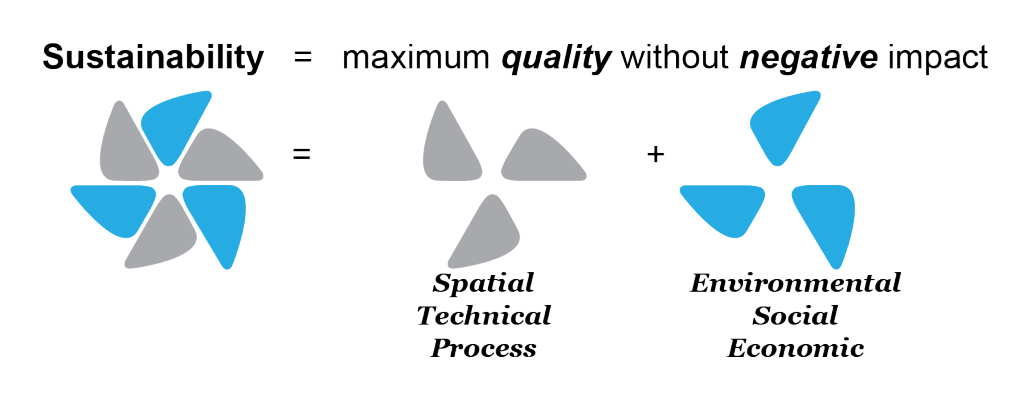
3. Hierarchy of knowledge.
‘Concepts have a hierarchical structure . . . the higher, more complex abstractions are derived from the simpler, basic ones…’
Ayn Rand (1979*) An Introduction to Objectivist Epistemology
As noted by Rand above, knowledge is hierarchical. In the process of working through sustainability, it is necessary to constantly zoom in and out of detail. Dan Hill (2012*) refers to this as skipping between the ‘meta’ (the bigger picture) and the ‘matter’ (the material detail). We’re used to this thinking through using web-based maps. If we pan out to see the world we only see countries and cities but if we zoom down, we can begin to read the name of the local cafe or street name.
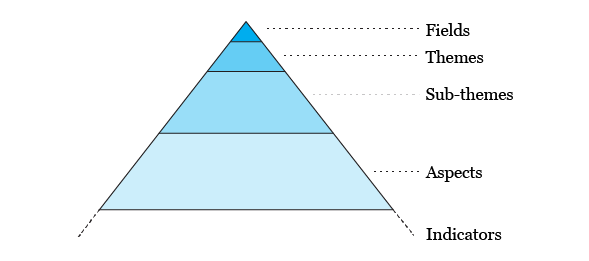
Systems thinker Russell Ackhof uses the metaphor of a pyramid to describe the steps between wisdom, knowledge, information and data (DIKW, see above). The challenge is how to categorise details in the Babushka Doll of knowledge. Is knowledge like a tree or like a web? Christopher Alexander in his 1966 article “A city is not a tree”* notes that the ‘…city is a semi-lattice, but it is not a tree…’.
In our case for example, is public space most related to Space or Society? Is water related to the Environment or Technology? Are shops about Society or about Economy? Are these part of one category or both?
We categorise knowledge based on how it services our six Fields. This means that in many cases the hierarchy of knowledge contains apparent overlaps and therefore the definitions are based on how they relate to the associated Field of sustainability. The nuance is subtle but critical. In other words, we consider shops to be a Societal issue based on the need to access goods and services but conversely the amount of commercial space is an Economic issue one due to possible jobs and economic potential. This means that shops are important to both society and economy however their service is different (and can be at times at odds).
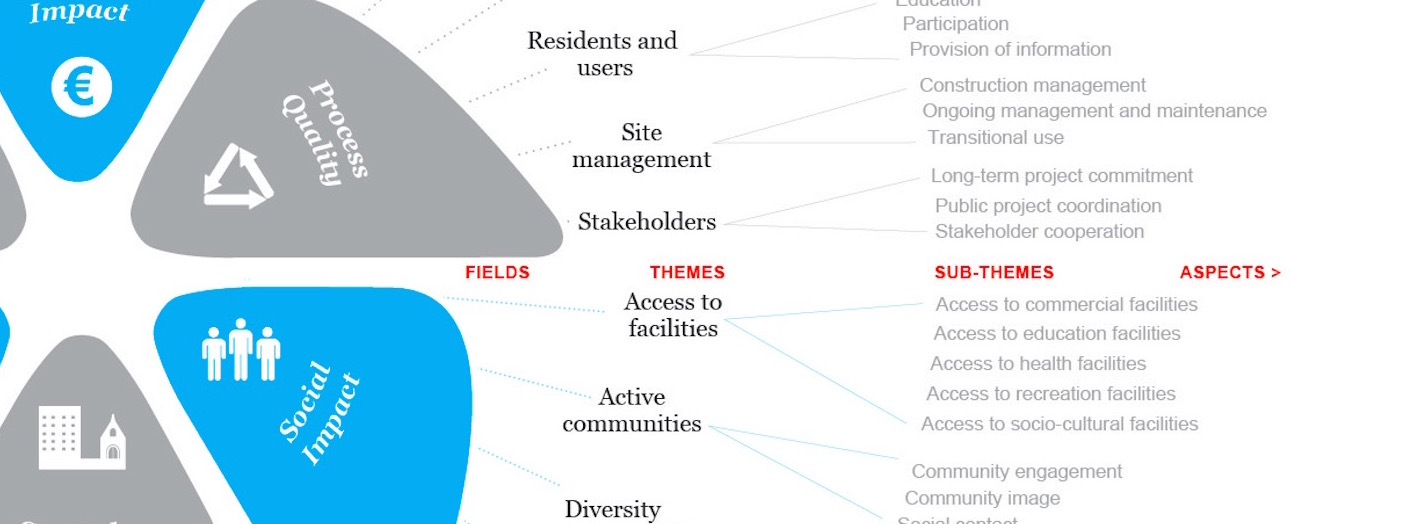
To elaborate further – the six Fields are the most basic level of information (for example Social Impact). These six Fields in effect are transferable to many other themes such as public health or politics. The Fields are followed by Themes (35 in total) broken down into more specific topics focused on urbanism, yet remain vague (such as Access to Facilities). The following level, Sub-themes (130), can be used to help evaluate and orientate projects and here we have assessment criteria and objectives (for example Access to Commercial Facilities). The final level, Aspects (350), are the most technical (like Access to Horeca) and can be used to assess a project with precise (qualitative and quantitative) assessment criteria but also contain very practical solutions. Indicators would site on a level below this.
The topics have been extracted from an extensive study of numerous Sustainability Assessment Methods and tools – overlaying relevant topics, indicators, objectives and seeking gaps in the overall story. The Assessment Methods researched including: BREEAM (Communities) , Duurzaamheidsmeter Gent (Economie + Stadsprojecten), DGNB, CEEQUAL, HQE, Star Communities, LEED (Neighbourhood Development) and others. To fill the gaps, we used extensive literature research on specific topics.
Themes
Themes are focused on particular issues which are relevant to all projects. We consider it essential to review every site on the Theme level – this can be done quickly and we call it a ‘quick-scan’ (refer to the Process page). All Themes are defined generally enough to trigger one to consider relevant issues, yet not precisely enough to give an indicator of performance. Often projects will have a Theme that performs badly (such as biodiversity in the centre of most cities) and despite this, it is important that this is acknowledged.
For example, a site may be considered to have poorly performing collective transport. On closer inspection it may have a good connection to buses and trains but there may be very few services per hour, it may have a very uncomfortable bus stop (or none at all) or there may be a lot of congestion.
Sub-Themes
Sub-themes contain an additional level of information which helps to focus really on the target issue.
Sub-themes can become real project objectives. This may include, for example, the improvement in water quality, the increase in building quality or the development of wind based energy production. Sub-themes allow a project to be focused, they can be used to evaluate the condition of a site (generally using qualitative indicators) however they are not specific enough to be considered indicators as such.
Aspects
Aspects are the lowest level of detail after Sub-themes. Aspects contain very specific details on how to interpret a problem.
For example the Sub-theme of Solid Waste includes Aspects such as; waste minimisation, waste processing an waste storage/collection.
Aspects include specific strategies or interventions however they are not what we consider an indicator. Each Aspect includes one or numerous indicators, both qualitative and quantitative, to assess the Aspect.
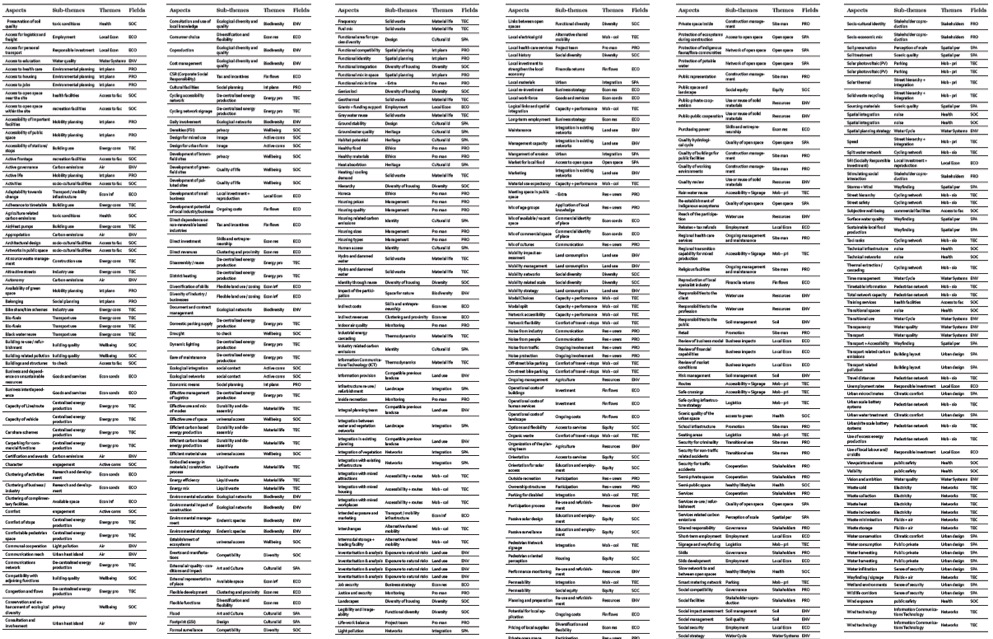
4. Leverage points.
‘Folks who do systems analysis have a great belief in ‘leverage points.’ These are places within a complex system where a small shift in one thing can produce big changes in everything.’
Intervening in a system can have larger consequences. This is best put by Donella Meadows (1999*) above. Knowing where to intervene is not necessarily intuitive. Conversely the results may lead unintended consequences.
The following diagram illustrates how the construction of a piece of technology – a wind turbine – can have a long knock-on effect into other areas. As shown, we split large topics into parts. This means that almost any urbanism issue can be thrown at the Compass and then split up into relative segments.
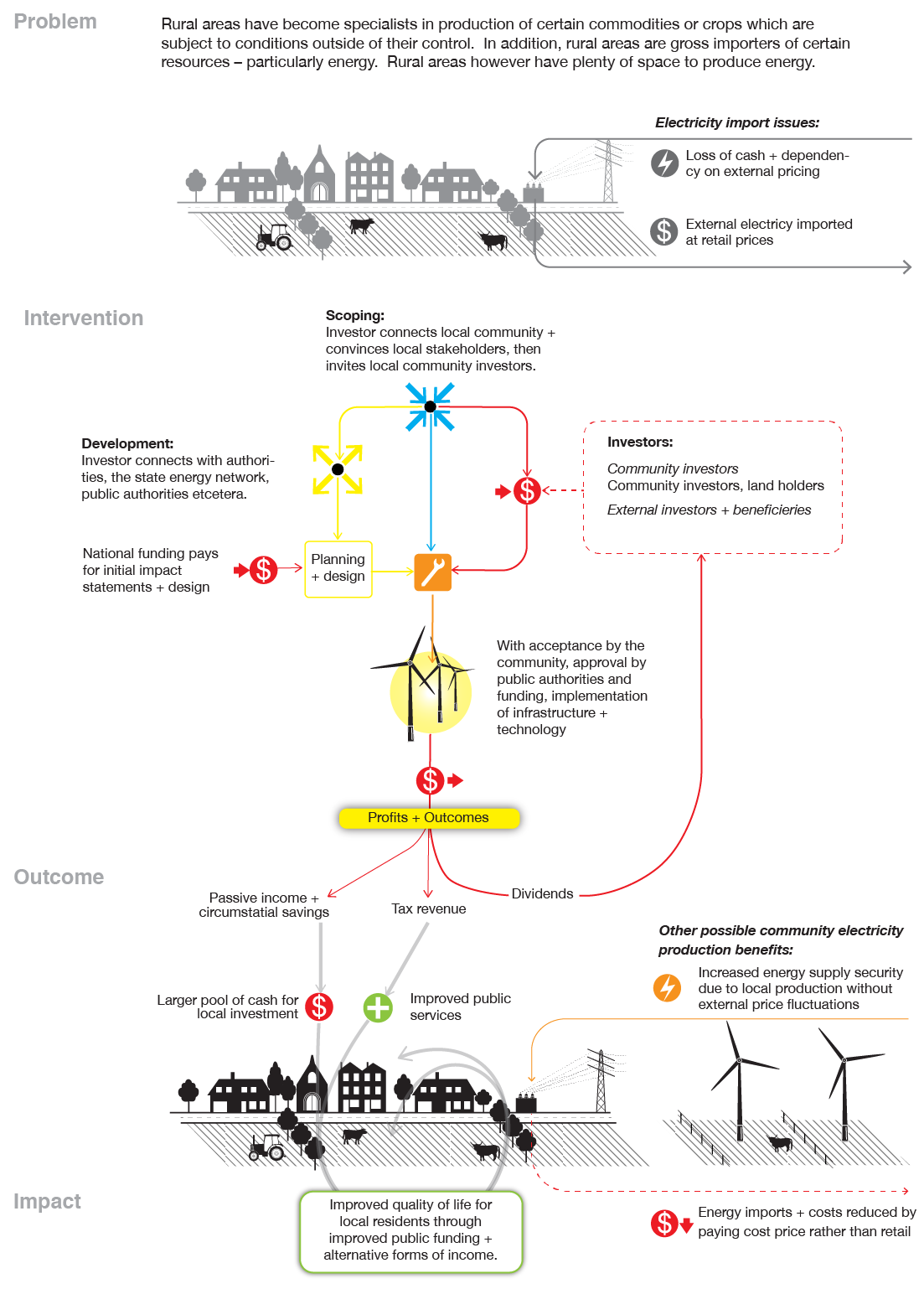
Consider the energy example above. Within Technical Quality the topic ‘Wind Energy’ can be found (under Energy Production) but this describes the technical qualities of wind technology. A wind turbine is much more than a piece of technology. If we were to consider the development of a wind turbine park we would naturally need to consider: if turbines are legally permitted according to zoning plans (Process Quality), how they fit into the landscape (Spatial Quality), what is the most appropriate configuration (Technical Quality and Environmental Quality), how will the community relate to the technology (Process Quality and Social Quality), what is the most effective financial model (Economic Impact), how can it be implemented over the long-term (Process Quality), how will the community benefit from the income and where will they invest it (Economic Impact) and so on.
In this way complex issues such as mobility, crime, energy, employment and density are split into numerous smaller issues and are not treated as an individual topic within the compass.
© All contents of this site is copyright to BUUR cvba. No reproduction without formal consent.


